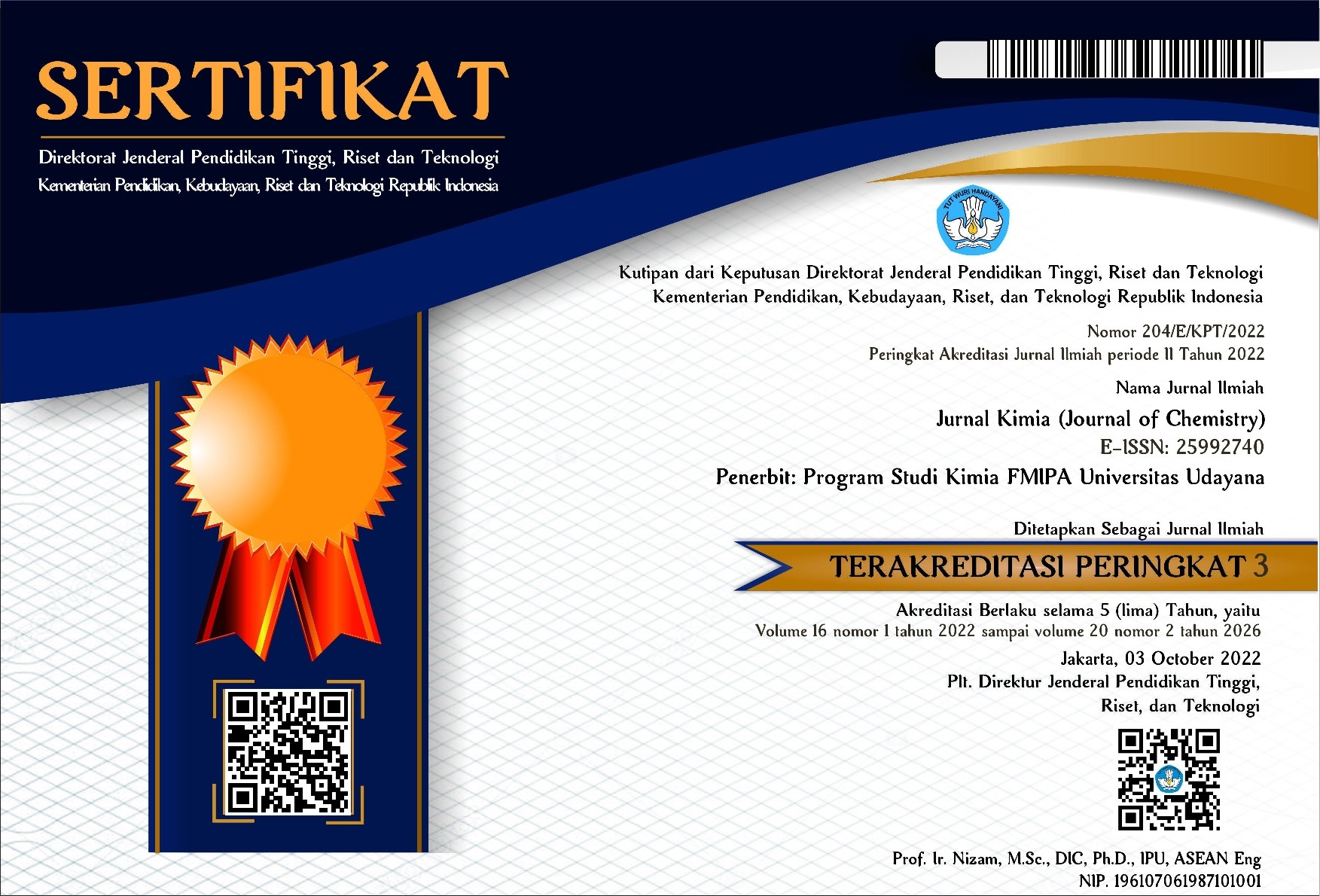SINTESIS DAN KARAKTERISASI BENTONIT-ZnO SERTA PEMANFAATANNYA DALAM DEGRADASI LIMBAH INDUSTRI PENCELUPAN
Abstract
ABSTRAK
Limbah yang dihasilkan dari industri tekstil berupa limbah cair yang keruh, berwarna dan sulit dihilangkan sehingga dapat mengganggu ekosistem perairan. Limbah hasil pencelupan dapat mencemari lingkungan karena menggunakan zat warna azo yang sulit untuk didegradasi. Salah satu metode yang dapat diaplikasikan untuk mengatasi ini adalah fotodegradasi. Dalam artikel ini dilaporkan sintesis fotokatalis bentonite-ZnO dan aplikasinya dalam fotodegradasi zat warna dalam limbah pencelupan. Karakterisasi fotokatalis dilakukan dengan melihat kristalinitas kompositnya menggunakan X-Ray Diffraction (XRD), luas permukaannya dengan metode methylene blue serta penentuan efektivitas degradasi dengan dan tanpa sinar. Difraktogram yang dihasilkan menunjukkan beberapa puncak dengan intensitas tinggi: pada 2? = 20,51° (d=4,32Å) yang menunjukkan adanya mineral kuarsa sedangkan pada 2? = 26,28° (d=3,39Å) mengindikasikan illit. Puncak khas dari ZnO ditunjukkan pada pola difraksi 2? = 36,18° (d=2,46Å) dan 2? = 59,64° (d=1,54Å). Luas permukaan bentonit dan bentonit-ZnO berturut-turut 183,0665 dan 180,2460 m2/g. Kondisi optimum yang diperoleh dalam mendegradasi zat warna limbah industri pencelupan yaitu massa 100 mg pada pH 2 dan waktu irradiasi atau pengadukan dalam gelap selama 45 menit. Degradasi dengan sinar lebih efektif (95,66 ± 0,16%) dibandingkan tanpa sinar (73,28 ± 0,55%) yang menunjukkan peran komposit bentonite-ZnO sebagai fotokatalis.
Kata kunci: Bentonit-ZnO, Fotodegradasi, Limbah Industri Pencelupan
ABSTRACT
Liquid waste generated by the textile industry is typically murky, intensely coloured, and hard to treat. As a consequence, it can pollute the aquatic ecosystem. One potential method to overcome this problem is photodegradation to break the dye molecules down. In this paper the synthesis of bentonite-ZnO composite and its application as a photocatalyst are reported. The composite was prepared by sonicating a mixture of zinc acetate and bentonite. The characterization of the composite was conducted using X-Ray Diffraction (XRD) and methylene blue method to determine its surface area, and its degradation capacity as photocatalyst to degrade the dye waste. The diffractogram reveals several peaks with high intensity, i.e. at 2? = 20,51° (d = 4,32Å) indicating mineral quartz, and at 2? = 26,28° (d = 3,39Å) showing Illite. The identifying peaks of the ZnO are in the diffraction pattern of 2? of 36,18° (d = 2,46Å) and 59,64° (d = 1,54Å). The surface area of the bentonite and bentonite-ZnO are 183,0665 and 180,260 m2/g respectively. The optimum conditions obtained for the dye degradation are 100 mg photocatalyst at pH 2 and irradiation time of 45 minutes. Degradation under UV light is more effective with a degradation percentage of 95,66 ± 0,16% than that in the dark, which is 73,28 ± 0,55%. This shows that the composite plays its role as a photocatalyst for the degradation.
Keywords: Bentonite-ZnO, Dyeing Industrial Waste, Photodegradation.
Downloads
References
Boutra, B., & Trari, M., 2016, Solar Photodegradation of A Textile Azo Dye Using Synthesized ZnO/Bentonite, Water Science and Technology, 75(5): 1211–1220.
Chen, C., Liu, J., Liu, P., and Yu, B., 2011, Investigation of Photocatalytict Degradation of Methyl Orange by Using Nano-Sized ZnO Catalysts, Advances in Chemical Engineering and Science, 1: 9-14
Diantariani, N.P., Suprihatin, I.E., Widihati, I.A.G., 2016, Synthesis of ZnO-AC composite and its use in reducing textile dyes concentrations of methylene blue and congo red by photodegradation, Cakra Kimia, 4(1): 1-7
Meshram, S., Limaye, R., Ghodke, S., Nigam, S., Sonawane, S., Chikate, R., 2011, Continuous flow photocatalytic reactor using ZnO–bentonit nanocomposite for degradation of phenol, Chem. Eng, J. 172: 1008–1015
Nogueira, R. F. P., and Jardim, W. F., 1993, Photodegradation of Methylene Blue Using Solar light and Semiconduktor (TiO2), Journal of Chemical Education, 70: 861-862
Sakthivel S., B. Neppolian, M. V. Shankar, B. Arabindoo, M. Palanichamy, and M. Murugesan. 2003, Solar Photocatalytic Degradation of Azo Dye: Comparison of Photocatalytic Efficiency of ZnO and TiO2, Solar Energy Material and Solar Cells, 77: 65 – 82
Sitepu, O.C., Ratnayani, O., Suprihatin, I.E., Sintesis komposit ZnO-bentonit dan penggunaannya dalam proses degradasi methyl orange,2016, Cakra Kimia, 4(2):154-163
Syuhada, Rachmat W., Jayatin, Saeful R., 2009, Modifikasi Bentonit (Clay) menjadi Organoclay dengan Penambahan Surfaktan, Jurnal Nanosains & Nanoteknologi, 2(1): 48-51.
Wahi, R. K., Yu, W. W., Liu, Y., Mejia, M. L., Falkner, J. C., Nolte, W., and Colvin, V. L., 2005, Photodegradation on Congo Red Catalyzed By Nanosized TiO2, Journal of Molecular Catalysys A : Chemical, 242: 48-56
Xu, H., Yu, T., Liu, J., 2014, Photodegradation of Acid Yellow 11 in Aqueous on Nano-ZnO/Bentonite Under Ultraviolet and Visible Light Irradiation, Materials Latters, 117: 263-265

This work is licensed under a Creative Commons Attribution 4.0 International License





